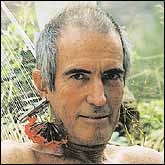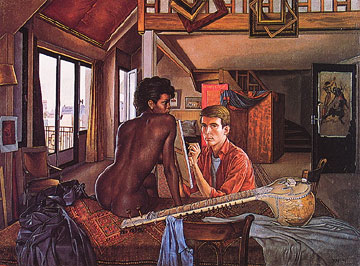|
|
VISIONARY REVUE
"I became an artist
because I couldn't become
anything else..."
|

photo: Raymond Martin
ABDUL MATI KLARWEIN
|
|
Mati Klarwein was born in Hamburg Germany on April 9, 1932. He was named Matthias (hence Mati) after the painter Matthias Grunewald. Later, he added the Arab name Abdul as a gesture towards improving Arab-Israeli relations (signing many of his canvases Abdul Mati Klarwein).
|
"I grew up in three different cultures," he said, "the Jewish, Islamic and the Christian. These circumstances and my family's stern resistance against being part of any kind of orthodoxy has made me the outsider I am today... That is also why I took the name Abdul."
When Klarwein was two years old, his family left Germany for Israel (then Palestine). In this way his Jewish father was able to escape Nazi persecution (his mother was non-Jewish). One of Klarwein's earliest memories was his arrival at the Port of Haifa with his mother, while his father waved at them from the pier. His parents later divorced and Klarwein lived with his mother in the village of Nahariya near the Lebanese border. It was here that he spent the better part of World War II.
"In class, I was non-existent, transparent, empty, non-responsive and practically never there," Klarwein later remembered. His father, an architect by profession, arranged for his son's early
|
|
|
|
|
PARIS - FALL 2004

ARTIST AND MODEL (1958)
|
admittance into the Bezalel Art Academy in Jerusalem.
In 1948, the 16-year old witnessed the withdrawal of British soldiers and the transformation of Palestine into Israel. His mother decided to escape the ensuing Israeli-Palestinean conflicts and emigrate to France.
Once in Paris, Klarwein studied painting at various schools - l'Ecole des Beaux Arts, Académie Julian and, from 1949 to 1951, with Fernand Léger. But, it was through his friendship with Ernst Fuchs that Mati Klarwein eventually learned the Mischtechnik, which he then used in all subsequent works. "Fuchs is the most psychedelic painter of all," he later proclaimed, "except Dali and Bosch, of course."
Klarwein settled quickly into Parisian life, spending many evenings in the jazz clubs of St. Germain des Prés and passing his summers on the beaches of St. Tropez. He rubbed shoulders with jazz musicians, artists and Existentialists like Boris Vian, Tristan Tzara and Jean-Paul Sartre.
|
|
|
|

